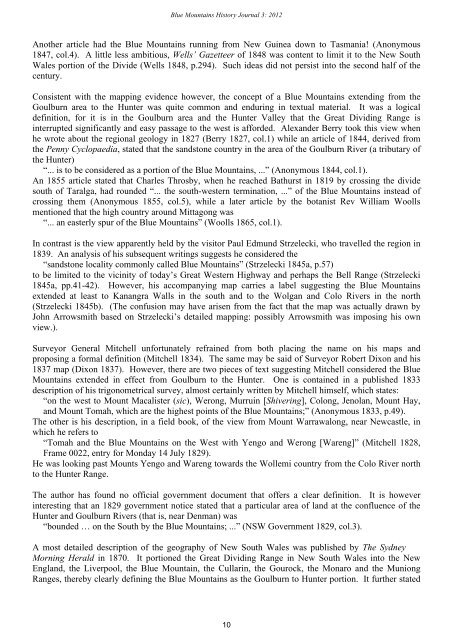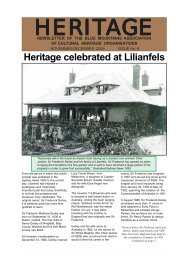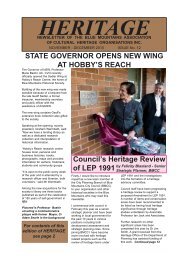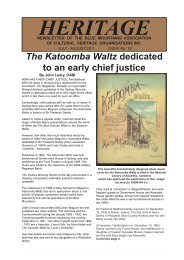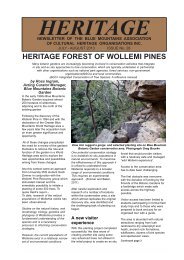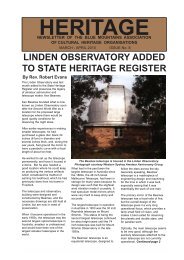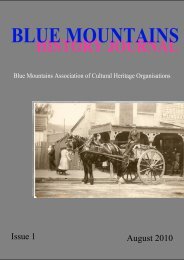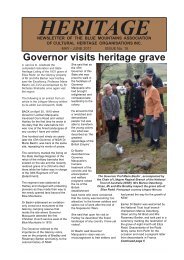Blue Mountains History Journal Issue 3
Blue Mountains History Journal Issue 3
Blue Mountains History Journal Issue 3
Create successful ePaper yourself
Turn your PDF publications into a flip-book with our unique Google optimized e-Paper software.
<strong>Blue</strong> <strong>Mountains</strong> <strong>History</strong> <strong>Journal</strong> 3: 2012<br />
Another article had the <strong>Blue</strong> <strong>Mountains</strong> running from New Guinea down to Tasmania! (Anonymous<br />
1847, col.4). A little less ambitious, Wells’ Gazetteer of 1848 was content to limit it to the New South<br />
Wales portion of the Divide (Wells 1848, p.294). Such ideas did not persist into the second half of the<br />
century.<br />
Consistent with the mapping evidence however, the concept of a <strong>Blue</strong> <strong>Mountains</strong> extending from the<br />
Goulburn area to the Hunter was quite common and enduring in textual material. It was a logical<br />
definition, for it is in the Goulburn area and the Hunter Valley that the Great Dividing Range is<br />
interrupted significantly and easy passage to the west is afforded. Alexander Berry took this view when<br />
he wrote about the regional geology in 1827 (Berry 1827, col.1) while an article of 1844, derived from<br />
the Penny Cyclopaedia, stated that the sandstone country in the area of the Goulburn River (a tributary of<br />
the Hunter)<br />
“... is to be considered as a portion of the <strong>Blue</strong> <strong>Mountains</strong>, ...” (Anonymous 1844, col.1).<br />
An 1855 article stated that Charles Throsby, when he reached Bathurst in 1819 by crossing the divide<br />
south of Taralga, had rounded “... the south-western termination, ...” of the <strong>Blue</strong> <strong>Mountains</strong> instead of<br />
crossing them (Anonymous 1855, col.5), while a later article by the botanist Rev William Woolls<br />
mentioned that the high country around Mittagong was<br />
“... an easterly spur of the <strong>Blue</strong> <strong>Mountains</strong>” (Woolls 1865, col.1).<br />
In contrast is the view apparently held by the visitor Paul Edmund Strzelecki, who travelled the region in<br />
1839. An analysis of his subsequent writings suggests he considered the<br />
“sandstone locality commonly called <strong>Blue</strong> <strong>Mountains</strong>” (Strzelecki 1845a, p.57)<br />
to be limited to the vicinity of today’s Great Western Highway and perhaps the Bell Range (Strzelecki<br />
1845a, pp.41-42). However, his accompanying map carries a label suggesting the <strong>Blue</strong> <strong>Mountains</strong><br />
extended at least to Kanangra Walls in the south and to the Wolgan and Colo Rivers in the north<br />
(Strzelecki 1845b). (The confusion may have arisen from the fact that the map was actually drawn by<br />
John Arrowsmith based on Strzelecki’s detailed mapping: possibly Arrowsmith was imposing his own<br />
view.).<br />
Surveyor General Mitchell unfortunately refrained from both placing the name on his maps and<br />
proposing a formal definition (Mitchell 1834). The same may be said of Surveyor Robert Dixon and his<br />
1837 map (Dixon 1837). However, there are two pieces of text suggesting Mitchell considered the <strong>Blue</strong><br />
<strong>Mountains</strong> extended in effect from Goulburn to the Hunter. One is contained in a published 1833<br />
description of his trigonometrical survey, almost certainly written by Mitchell himself, which states:<br />
“on the west to Mount Macalister (sic), Werong, Murruin [Shivering], Colong, Jenolan, Mount Hay,<br />
and Mount Tomah, which are the highest points of the <strong>Blue</strong> <strong>Mountains</strong>;” (Anonymous 1833, p.49).<br />
The other is his description, in a field book, of the view from Mount Warrawalong, near Newcastle, in<br />
which he refers to<br />
“Tomah and the <strong>Blue</strong> <strong>Mountains</strong> on the West with Yengo and Werong [Wareng]” (Mitchell 1828,<br />
Frame 0022, entry for Monday 14 July 1829).<br />
He was looking past Mounts Yengo and Wareng towards the Wollemi country from the Colo River north<br />
to the Hunter Range.<br />
The author has found no official government document that offers a clear definition. It is however<br />
interesting that an 1829 government notice stated that a particular area of land at the confluence of the<br />
Hunter and Goulburn Rivers (that is, near Denman) was<br />
“bounded … on the South by the <strong>Blue</strong> <strong>Mountains</strong>; ...” (NSW Government 1829, col.3).<br />
A most detailed description of the geography of New South Wales was published by The Sydney<br />
Morning Herald in 1870. It portioned the Great Dividing Range in New South Wales into the New<br />
England, the Liverpool, the <strong>Blue</strong> Mountain, the Cullarin, the Gourock, the Monaro and the Muniong<br />
Ranges, thereby clearly defining the <strong>Blue</strong> <strong>Mountains</strong> as the Goulburn to Hunter portion. It further stated<br />
10


